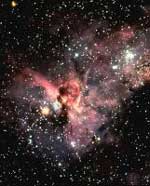
Just how dense is Titan’s atmosphere expected to be, and how did that influence the design of the probe? – Kepesk
The atmosphere of Titan is denser and thicker than that of the Earth. The surface pressure is 1.5 times that on Earth (1500 mbar). But because Titan gravity is 1/6 of Earth’s, the atmosphere is much more expanded. Huygens will brake at about 300 km altitude, while Earth re-entry vehicles brake at about 60 km altitude.
The probe was designed to brake as high as possible for allowing in-situ sampling of the atmosphere as high as possible (about 165 km). It required a large heat-shield.
The heat-shield design was influenced by the presence of methane in the atmosphere. Methane and nitrogen break apart in the shock layer that forms in front of the probe during the hypersonic entry and form the CN radical which is a strong emitter of violet radiation (during the entry, Huygens radiates as much as 1000 sun for about 30 sec). CN radiates a lot of heat on the heat-shield. The amount of radiation (heat flux) on Huygens heat shield is 3 to 4 times higher than if we would enter in a pure nitrogen atmosphere.
How did Titan “collect” so much organic material and get such a dense atmosphere? Did Titan “collect” the stuff or was the moon lucky and manage not to lose it? – baselle
This is a fundamental question. Answering it is a major scientific objective of the Cassini-Huygens mission. Most (if not all) of the organic matter in Titan’s atmosphere and on the surface comes from the chemical processing of methane. The origin of methane is one of the big mysteries that Huygens should help to solve.
What design considerations were made on the probe to help ensure it would survive a trip to Saturn that took it on flybys to a few other planets along the way? – dave_f
The main design considerations for Huygens long trip to Saturn were to ensure that the temperature of its batteries would be kept cool enough. Huygens is protected by a multi-layer insulation thermal blanket and protected from the sun by the orbiter high-gain antenna until we reached Jupiter. Regular (bi-annual) activations of Huygens during a few hours were designed to monitor its health and calibration and to activate movable instrument mechanisms for their maintenance.
Survived landing will be a bonus, not the goal, with this in mind, was there anything other than timing and synchronicity with the orbiter considered when choosing a “landing” site? – tiderider
Huygens is not a lander. So I prefer to talk about impact or touchdown site. The impact site was not specifically chosen. The main drivers were: i) the entry angle in the atmosphere, ii) the need to descend in the sunlit side of Titan, iii) a low to medium latitude descent, but away from the equator for best wind measurements, and iv) an optimized geometry for the radio link with the orbiter.
Supposing that remarkable observations where recorded by Huygens, how could such observations contribute to our understanding of the solar system evolution? – Keemah
The detailed in-situ measurements by Huygens will be combined with the several-year global observations by the Cassini orbiter during its planned 45+ (more if the mission is extended) Titan flybys in order to better understand the weather on Titan, the chemical composition of the atmosphere, the origin and fate of the methane. In-situ isotopic measurements are a key for understanding the origin and evolution of Titan’s atmosphere. Understanding why Titan has a thick atmosphere (the only moon in the solar system to have a substantial atmosphere) will allow testing theories of planetary formation and evolution.
Are there some atmospheric (or even surface) conditions expected to disturb data transmission from Huygens to Cassini? – Lamahe
The atmosphere is transparent to radio communication between Huygens and Cassini (at 2 GHz). Too large a swing under the parachute may disturb the communication for a few seconds but Huygens will transmit on two radio channels. Key data are transmitted on the two channels but delayed by 6 sec on one of the two channels. This delay will allow all important data to be recovered if the link is interrupted for a short time.
If all goes well, how soon will detailed information about what did the probe observe be made available to the public? Is there a period when certain scientists have exclusive access? – antoniseb
Information will be made available to the public within hours after the data are received on earth on 14th January. Scientists will make every effort to make as much information as possible to the public. But scientists will also publish their research results in scientific literature within months. All Huygens data will be made available to the wide scientific community and to the public at large through ESA and NASA Planetary data archives in 2006.
What advice would you give someone who’s willing to work in space research? – Ola D.
You need to get a good education is mathematics, physics and chemistry, but also in literature and history of sciences in order to be able to communicate your research results to the public. You also need to be motivated to embrace a research career as jobs are difficult to get and not always well paid. If you want to undertake planetary research you need patience and to be unselfish. It took more than twenty years to get to Saturn from mission idea to the arrival. It will take years and decades to analyze all the data that will be returned by Cassini-Huygens. A mission such as Cassini-Huygens goes across generations. Cassini-like missions to Uranus and Neptune will take longer. But it is so exciting to be involved in such voyages that I would encourage all school boys and girls to study sciences and take a chance. It’s worth it. One more piece of advice. Cassini-Huygens is a true example of highly successful international collaboration. Learn a few languages as it will help to enjoy your trips abroad and best appreciate the multi-cultural environment you will work in as I am convinced that planetary exploration must be undertaken through multi-national collaborations.

